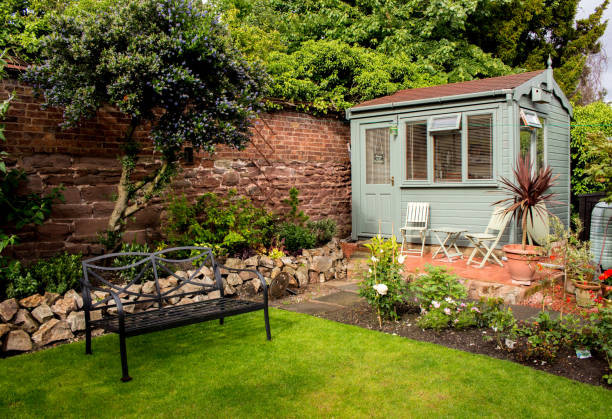With rising summer temperatures, maintaining a comfortable shed environment is crucial for protecting stored items and the structure itself. This article explains effective ventilation and cooling techniques—from natural vents to DIY modifications—that suit various shed types and sizes.
What Are the Best Shed Ventilation Methods for Summer?
Effective ventilation removes hot air and brings in cooler outdoor air. Popular methods include installing gable vents that let warm air escape, soffit vents under eaves that draw in cool air, and ridge vents along the roof peak for continuous exhaust. Together, these vents can lower interior temperatures significantly while reducing moisture and mold risk.
How Do Gable, Soffit, and Ridge Vents Improve Shed Airflow?
These vents create a natural convection current. Gable vents at the ends let heat escape, while soffit vents bring cool air in. Ridge vents provide a continuous exit path for warm air, which balances air exchange, lowers temperatures, and minimizes moisture buildup, keeping the shed comfortable even during hot days.
Can Installing Exhaust or Ceiling Fans Help Cool Your Shed?
Yes, mechanical fans like exhaust or ceiling fans boost airflow where natural ventilation is limited. They quickly remove pockets of heat and lower temperatures by 10–15°F when used alongside natural vents. This extra airflow is particularly useful in larger or less ventilated sheds.
What Role Do Portable Fans Play in DIY Shed Cooling?
Portable fans offer immediate, flexible cooling solutions. Easily repositioned, they help circulate air in tight spaces, such as around a workbench or storage area. Their versatile use makes them a cost-effective addition to other strategies like insulation and window coverings.
How Can You Maintain Optimal Shed Temperature During Hot Months?
Controlling shed temperature in summer involves proper ventilation, insulation, and shading. Reflective roof treatments, light-colored exterior paint, and materials like radiant barriers reduce solar heat gain. Regular maintenance and monitoring ensure that the shed remains cool and energy-efficient.
Which Insulation Materials Are Most Effective for Summer Heat?
Insulation with high reflectivity and low thermal conductivity works best. Radiant barrier insulation, for example, reflects heat and can reduce temperature rise by up to 20%. Foam board and fiber cement sheathing also help by minimizing heat transfer when properly installed and sealed.
How Does Proper Shade and Window Covering Reduce Shed Heat?
External shading devices like awnings and adjustable louvers block direct sunlight, while interior solutions such as reflective films and light curtains deflect heat. These methods can lower the shed’s temperature by 10–15°F and are especially effective in areas with intense sunlight.
How Can You Implement DIY Shed Cooling Methods?
DIY cooling methods offer cost-effective ways to boost ventilation without major renovations. Techniques include creating cross-ventilation and applying reflective roof treatments. Integrating simple modifications can rapidly reduce the shed’s temperature and improve overall air circulation.
How to Create Cross-Ventilation in Your Garden Shed?
Place intake vents on one wall and exhaust vents on the opposite side to set up a directional airflow. Even repositioning doors and windows to capture prevailing breezes enhances cross-ventilation, drawing in cooler outside air while pushing warm air out.
What Simple Modifications Can Improve Air Circulation?
Minor changes such as adjusting door positions, trimming surrounding foliage, and adding mesh covers on windows can boost airflow. Creating extra openings with simple tools can help evenly distribute air throughout the shed, avoiding hot pockets.
How to Use Reflective Paints and Roof Treatments to Lower Heat?
Light-colored and heat-reflective paints minimize heat absorption by reflecting sunlight. Combined with proper roof treatments, these measures reduce conductive heat buildup inside the shed and extend the longevity of roofing materials.
How Do You Choose the Right Ventilation System for Your Shed Type?
Choosing a ventilation system depends on the shed’s design, size, and location. Whether it’s a barn-style shed with a loft or a small storage building, assess the space carefully to select the right combination of vents, fans, and insulation. A blend of passive and active options ensures efficient heat management.
What Factors Affect Ventilation Needs Based on Shed Size and Location?
Larger sheds with high ceilings often need more vents for adequate exhaust, while smaller sheds may do well with a simpler system. The shed’s geographic setting—open field versus shaded backyard—and local wind patterns also influence the optimal design of the ventilation system.
How to Match Vent Types to Different Shed Designs?
Different shed styles require customized vent choices. For instance, a barn-style shed with a loft may benefit from a combination of ridge and soffit vents for multi-level airflow, whereas flat-roofed utility sheds may rely on sidewall vents and ceiling fans. Manufacturers’ guidelines can help ensure both aesthetic appeal and performance.
When Is It Worth Investing in Pre-Insulated or Ventilated Sheds?
For long-term savings and durability, investing in pre-insulated or pre-ventilated sheds is worthwhile. These options lower maintenance costs by integrating temperature regulation and moisture protection from the start, making them attractive for both home storage and business use.
What Are Common Mistakes to Avoid When Ventilating a Garden Shed?
Avoiding common pitfalls in shed ventilation is key. Errors such as awkward vent placement or excessive insulation without proper venting can hinder airflow, leading to stagnant air and increased internal temperatures.
Why Is Poor Vent Placement Harmful to Shed Cooling?
Incorrectly positioned vents create uneven temperatures, with pockets of hot and cold air. This imbalance undermines the cooling process and can accelerate wear on stored items. Well-planned vent placement is essential for uniform temperature control.
How Can Over-Insulating Backfire in Summer Shed Ventilation?
While insulation helps retain cool air, too much can trap heat inside if not balanced with sufficient ventilation. Over-insulation can lead to a buildup of warmth and negatively affect comfort, emphasizing the need for a balanced approach.
What Maintenance Practices Keep Ventilation Systems Effective?
Regular cleaning of vents, fans, and insulation ensures unobstructed airflow. Periodic inspections and prompt repairs help maintain system performance, preserving a cool and safe interior environment over time.
How Can You Monitor and Improve Shed Air Quality and Comfort?
Monitoring the shed’s internal conditions is vital. Tools like thermometers and hygrometers allow you to track temperature and humidity, enabling timely adjustments. This proactive approach prevents mold growth and structural deterioration.
What Tools Help Measure Temperature and Humidity Inside Sheds?
Compact digital thermometers and hygrometers offer accurate readings. Some models even connect to smartphones for real-time alerts, ensuring that fluctuations are quickly addressed to maintain a comfortable microclimate.
How Does Ventilation Impact Mold Prevention and Shed Longevity?
Efficient ventilation lowers moisture levels and reduces the likelihood of mold. By ensuring a steady exchange of air, the system protects both the structure and stored items from long-term damage.
What Are the Benefits of Combining Ventilation With Dehumidifiers?
Using dehumidifiers alongside proper ventilation further controls moisture levels. This combination creates a stable environment that keeps the shed cool and dry, which is especially beneficial in humid conditions.
Which Products Are Recommended for Effective Summer Shed Ventilation?
Choosing the right cooling products is vital. High-quality vents, fans, insulation kits, and shading accessories are available from trusted brands. These products are designed to deliver energy-saving benefits and durable performance without complicated installations.
What Are the Top-Rated Vents and Fans for Garden Sheds?
Ridge vents with adjustable louvers, soffit vents for optimal intake, and robust exhaust fans are frequently recommended. Users appreciate these products for their efficiency, ease of installation, and ability to significantly lower shed temperatures.
How to Select Insulation and Shade Accessories for Maximum Cooling?
Select materials known for their reflective properties, such as radiant barriers and insulated panels. Comparing R-values and installation ease helps ensure that chosen products meet both the performance and budget requirements.
Where to Find Trusted Brands and Solutions for Shed Cooling?
Reputable brands like those available at Home Depot or Lowe’s offer specialized shed cooling solutions. Customer reviews and expert recommendations can guide you in selecting reliable products that enhance airflow and reduce heat buildup.
Before making decisions, review comparative tables and product features to choose solutions that match your shed’s specific cooling needs.
Frequently Asked Questions
Q: What is the most crucial factor in effective shed ventilation?
A: Proper vent placement directly influences airflow efficiency and heat reduction.
Q: How do radiant barriers improve shed cooling?
A: They reflect solar heat away, lowering the temperature and energy costs.
Q: Can DIY modifications really lower shed temperature?
A: Yes, simple steps like cross-ventilation and reflective paints can significantly improve cooling.
Q: Are portable fans an effective solution in small sheds?
A: Absolutely; they supplement natural airflow and provide flexible cooling options.
Q: How often should ventilation systems be maintained?
A: Regular maintenance every few months is recommended to ensure peak performance.
Conclusion
Effective summer shed ventilation is essential for a cool, safe storage environment. By combining passive and active cooling solutions—such as gable, soffit, and ridge vents with exhaust fans and proper insulation—homeowners can reduce heat buildup and extend the life of their shed. With careful product selection and regular maintenance, every summer can be comfortable and energy efficient.




